Nov 14, 2018
Featured, Design Build
Modularity Design Trend
A new trend has hit the design world. Hello, Modularity. Modular design is a design approach that creates things out of independent parts with standard interfaces. This allows designs to be customized, upgraded, repaired and for parts to be reused.
In the interior design world, modular designs have begun to take the form of various acoustic tiles and even modular wall solutions. These allow clients to make less of an impact on the space. For larger organizations, modular design means that if a setup isn’t working, it’s possible to change it. Modular design provides the flexibility and future-proofing that most clients are now asking for.

Retail designers have referenced local architecture in their modular product displays, allowing a visible connection between a city’s history and the interior space. Look at this design space, Modular Lilong, that creates a retail experience specifically related to the surrounding context of Shanghai. The term ‘lilong’ refers to an urban typology in response to space shortage, with buildings organized around meandering lanes. They re-interpreted the signature streetscape with 3 ‘lanehouses’ arranged into different display areas. The structure of ‘lanehouses’ is conceived as a modular kit of parts, so that it can easily be disassembled and re-installed in another shop location if needed. The materials are also based on architectural features and textures found in a ‘lilong’.

Modular units within commercial designs can allow for interior function flexibility and multi-purpose spaces. With BOY Siam Square salon, they developed a way to tie two levels together with a loop of continuous steel rod, serving as a structure for the new mobile cutting units. This raw steel rod runs from the front reception to the cutting area, up through the open void, into the waiting and multi-purpose area, and back down in a continuous loop, weaving different functions into a united space. Mirror units and shelving units are designed to hang on this rod system rather than attaching to walls, so furnishings can be positioned to fit any purpose or situation. The space is minimized down to its main functions, yet allows dynamic adaptability to serve the users.
The concept of modularity is becoming increasingly popular among interior designers in a quest to make products more individual and economically viable. Modular design seeks to divide a design into smaller modules that can be independently produced and used. Everything from architecture to interior design to the way computers or even cars are built can be modular in nature. Modular designs have multiple uses, this way of life is also considered eco-friendly and good for the environment. Modular units within commercial designs can allow for interior function flexibility and multi-purpose spaces. From the amount of people on this Earth, to the “green living” trend that has overtaken our culture point towards modular living as a way of life for the future. Interested in learning more about modularity designs? Or how to incorporate it into your space? Contact us at Info@SensorySix.com to learn more.
Content:
https://de-production-media.s3.amazonaws.com/loft/2464/2018_Commercial_Trends.pdf
Photo:
https://i.pinimg.com/originals/b9/2d/66/b92d66ca3f6673290793fb83683b17db.jpg
https://images.adsttc.com/media/images/57ad/4f4e/e58e/ceaf/f600/01bd/newsletter/Lukstudio_Modular_Lilong-04.jpg?1470975815
https://images.adsttc.com/media/images/57ad/4f10/e58e/cef5/d400/03d0/newsletter/Lukstudio_Modular_Lilong-05.jpg?1470975752
https://www.e-architect.co.uk/wp-content/uploads/2016/07/the-modular-lilong-l290716-9.jpg
https://images.adsttc.com/media/images/598a/7481/b22e/3893/9200/0787/large_jpg/BOY_19.jpg?1502245997
https://i.pinimg.com/originals/c6/03/1b/c6031b27570a25a90bb6631659b5c98b.jpg
http://retaildesignblog.net/wp-content/uploads/2017/08/BOY-Siam-Square-Salon-by-Stu-D-O-Architects-Bangkok-Thailand-09.jpg




